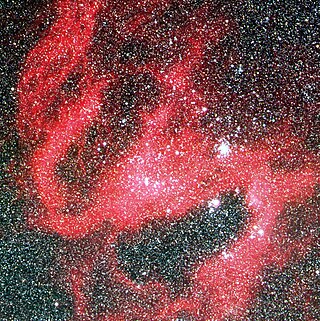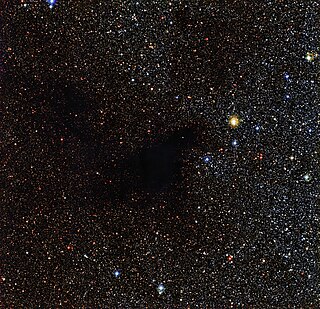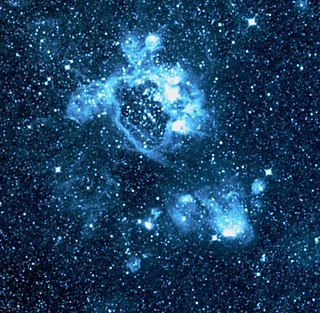
The Large Magellanic Cloud (LMC) is a dwarf irregular galaxy, and satellite galaxy of the Milky Way. At a distance of around 50 kiloparsecs (163,000 light-years), the LMC is the second- or third-closest galaxy to the Milky Way, after the Sagittarius Dwarf Spheroidal (c. 16 kiloparsecs (52,000 light-years) away) and the possible dwarf irregular galaxy called the Canis Major Overdensity. Based on the D25 isophote at the B-band (445 nm wavelength of light), the Large Magellanic Cloud is about 9.86 kiloparsecs (32,200 light-years) across. It is roughly one-hundredth the mass of the Milky Way and is the fourth-largest galaxy in the Local Group, after the Andromeda Galaxy (M31), the Milky Way, and the Triangulum Galaxy (M33).

Wolf–Rayet stars, often abbreviated as WR stars, are a rare heterogeneous set of stars with unusual spectra showing prominent broad emission lines of ionised helium and highly ionised nitrogen or carbon. The spectra indicate very high surface enhancement of heavy elements, depletion of hydrogen, and strong stellar winds. The surface temperatures of known Wolf–Rayet stars range from 20,000 K to around 210,000 K, hotter than almost all other kinds of stars. They were previously called W-type stars referring to their spectral classification.

The Tarantula Nebula is a large H II region in the Large Magellanic Cloud (LMC), forming its south-east corner.

S Doradus is one of the brightest stars in the Large Magellanic Cloud (LMC), a satellite galaxy of the Milky Way, located roughly 160,000 light-years away. The star is a luminous blue variable, and one of the most luminous stars known, having a luminosity varying widely above and below 1,000,000 times the luminosity of the Sun, although it is too far away to be seen with the naked eye.

In astronomy, extinction is the absorption and scattering of electromagnetic radiation by dust and gas between an emitting astronomical object and the observer. Interstellar extinction was first documented as such in 1930 by Robert Julius Trumpler. However, its effects had been noted in 1847 by Friedrich Georg Wilhelm von Struve, and its effect on the colors of stars had been observed by a number of individuals who did not connect it with the general presence of galactic dust. For stars lying near the plane of the Milky Way which are within a few thousand parsecs of the Earth, extinction in the visual band of frequencies is roughly 1.8 magnitudes per kiloparsec.

In astronomy a superbubble or supershell is a cavity which is hundreds of light years across and is populated with hot (106 K) gas atoms, less dense than the surrounding interstellar medium, blown against that medium and carved out by multiple supernovae and stellar winds. The winds, passage and gravity of newly born stars strip superbubbles of any other dust or gas. The Solar System lies near the center of an old superbubble, known as the Local Bubble, whose boundaries can be traced by a sudden rise in dust extinction of exterior stars at distances greater than a few hundred light years.

NGC 2060 is a star cluster within the Tarantula Nebula in the Large Magellanic Cloud, very close to the larger NGC 2070 cluster containing R136. It was discovered by John Herschel in 1836. It is a loose cluster approximately 10 million years old, within one of the Tarantula Nebula's superbubbles formed by the combined stellar winds of the cluster or by old supernovae.

HD 269810 is a blue giant star in the Large Magellanic Cloud. It is one of the most massive and most luminous stars known, and one of only a handful of stars with the spectral type O2.

LH 54-425 is a spectroscopic binary star system in the LH 54 OB association within the Large Magellanic Cloud in the constellation Dorado.

R136a1 is one of the most massive and luminous stars known, at nearly 200 M☉ and nearly 4.7 million L☉, and is also one of the hottest, at around 46,000 K. It is a Wolf–Rayet star at the center of R136, the central concentration of stars of the large NGC 2070 open cluster in the Tarantula Nebula in the Large Magellanic Cloud. The cluster can be seen in the far southern celestial hemisphere with binoculars or a small telescope, at magnitude 7.25. R136a1 itself is 100 times fainter than the cluster and can only be resolved using speckle interferometry.

AB7, also known as SMC WR7, is a binary star in the Small Magellanic Cloud. A Wolf–Rayet star and a supergiant companion of spectral type O orbit in a period of 19.56 days. The system is surrounded by a ring-shaped nebula known as a bubble nebula.

LH 41-1042 is a Wolf–Rayet star located in the Large Magellanic Cloud (LMC). It is an extremely rare member of the WO oxygen sequence, the second to be discovered in the LMC and one of only three found so far in that galaxy.

N119 is a spiral-shaped H II region in the Large Magellanic Cloud. Its dimensions are large, at 131 x 175 pc. It contains several luminous stars including S Doradus, LH41-1042, and LMC195-1. Its peculiar S-shaped structure is difficult to explain with classical models.

LHA 120-N 55 or N55 is an emission nebula located within the Large Magellanic Cloud (LMC). N55 is situated inside a superbubble called LMC 4. It is a glowing clump of gas and dust that gets its light output from the hydrogen atoms shedding electrons within it. It was named in 1956, in a catalogue of H-alpha emission line objects in the LMC.

N41 is an emission nebula in the north part of the Large Magellanic Cloud in the Dorado constellation. Originally catalogued in Karl Henize's "Catalogue of H-alpha emission stars and nebulae in the Magellanic Clouds" of 1956, it is approximately 100 light-years wide and 160,000-170,000 light-years distant.

Hen 2-131 is a planetary nebula in the southern constellation of Apus. It was discovered by Andrew David Thackeray in 1950 and added to the Catalogues of Hα-emission Stars and Nebulae in the Magellanic Clouds by Karl Gordon Henize in 1967.

WOH S264 is a large, highly luminous red supergiant star in the Large Magellanic Cloud.
BAT99-123, also known as Brey 93, is a rare WO-type Wolf–Rayet star located in the Large Magellanic Cloud, about 160,000 light years away in Dorado. BAT99-123 was the first WO star discovered in the LMC, and only 3 are known to exist in the galaxy, the other two being LH 41-1042 and LMC195-1.

















